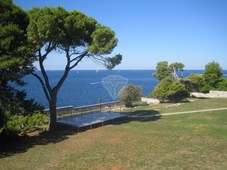to enlarge


or choose the place
from the menu below
 Rome |
 Byzantium |
 Venice |
 Vienna |
 Brioni |
 Smrikve |
 |
 |
The sanctuary and the choir of the church are decorated with rich stucco works made in 1750 by the Venetian masters Giovanni Lattuga and Giovanni Barengo Napolachi.
The church also hosts the uncompleted Antique sarcophagus from the 2nd and 3rd century which belonged to the Antique church of St. George.
The bell tower is topped by almost 4 meters high bronze sculpture of the patroness of the town made by Vincenzo and Bisto Vallani from Maniago. This bronze sculpture of St. Euphemia was placed on the top of the bell tower in 1758 because two years before a wooden sculpture of St. Euphemia was burned by a thunderbolt.
 The stone made façade
of the church was completed in 1861. During the summer, if you are lucky, you may have the opportunity to enjoy a classical
music concert in St. Euphemia.
The stone made façade
of the church was completed in 1861. During the summer, if you are lucky, you may have the opportunity to enjoy a classical
music concert in St. Euphemia.
Given the fact that St. Euphemia is placed on the hilltop I would advise you to visit some other buildings that are worth to be seen that are located in this northern part of Rovinj, just above the Svalbe street where we started the visit.
To visit this part, before arriving in front of the façade of St. Euphemia, you will note, on your left side, the remains of the older town walls. On your left side you will have the remains of the town walls and the bell tower of the St. Euphemia on your right side. As I wrote before the houses that are located near to the sea were built in the second half of the 17th century and before that expansion of the town the town limit were the walls you can see in this part.
Another fact that is interesting to mention, before we continue the visit, is that Rovinj had a significant increase of inhabitants in the past centuries and the space for building new houses was limited.
Due to this reasons houses were built quite tall if we consider when most of this buildings were built.
You will note that most of the houses have four floors. It is interesting that each floor had one room and its own fireplace. This is the reason why there are so many chimneys on the roofs.
Few other interesting buildings are located in the parallel street to Svalbe street that goes above it. This two buildings are located nearby the downside part of the hill.
_small.jpg) Just take the road that continues where the old town walls ends and continue to walk
for another fifty meters. You will note the front façade and the particular stairs of the Church of St. Thomas.
The church was built in 1388 and later on restructured several times in: 1723, 1770, 1856 and in 1963. The stucco works inside
the church were made by Simon Battistella in the mid of the 18th century. The church has a particular stair in front of it
and a large vault below the left side of the church where the street continues.
Just take the road that continues where the old town walls ends and continue to walk
for another fifty meters. You will note the front façade and the particular stairs of the Church of St. Thomas.
The church was built in 1388 and later on restructured several times in: 1723, 1770, 1856 and in 1963. The stucco works inside
the church were made by Simon Battistella in the mid of the 18th century. The church has a particular stair in front of it
and a large vault below the left side of the church where the street continues.
When you are in the vault underpass you will note few stairs that allow you to turn left. Take these stairs that goes towards left and than take the street that goes on right. At the end of the street you will note a yellow building on your left side of the street and this is the Oratorial of Our Lady from 1482.
This virtual visit follows the path I followed when I was taking the pictures for the photo gallery but any street you take in the old town of Rovinj will charm you.
Lets return in front of St. Euphemia to enjoy the sea view. You will note another small wall in front of the church where most of the people take pictures both of the sea and of St. Euphemia. This western wall was also part of the old town walls as the northern walls we have seen before and below. You will note a larger square area below this town walls. This area was the old cemetery.